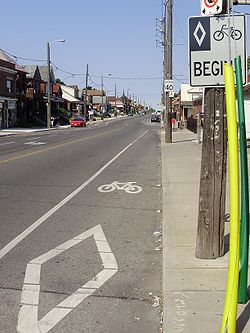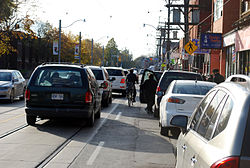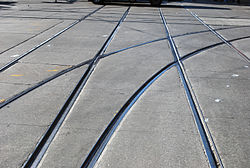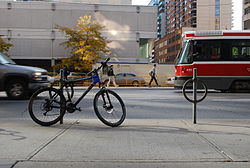- Cycling in Toronto
-
Cycling in downtown Toronto, November 2011

Toronto, like many North American cities, has slowly been improving its cycling infrastructure. At the same time the number of cyclists has been increasing progressively, particularly in the core, as cycling conditions improve, a cycling culture strengthens and alternatives such as automobiles are seen as expensive and cumbersome.
Contents
History
Toronto was no exception when the penny-farthing, and later the safety bicycle, arrived in North American cities in the late 19th century. This predated the advent of the automobile. The roads at the time were not ideal for bicycle travel. With the advent of the automobile the romance of the bicycle faded. It wasn't until the 10-speed bike boom of the 1970s that use of the bicycle for transportation in Toronto regained some traction.
In 1975, the Toronto City Cycling Committee was established by the former City to promote cycling and safety initiatives. It was composed of cycling advocates, City Councillors and volunteers. In forming the Committee, Council adopted the following policy statement: “Council recognizes that the bicycle, as an integral and efficient form of transportation and as a means of recreation, can make a significant contribution to the quality of City life; therefore, it is the policy of Council to implement programs that will promote and facilitate greater and safer use of the bicycle.”[1]
In 2001, Toronto City Council adopted the Toronto Bike Plan with the aim of doubling the number of cycling trips and reducing crashes and injuries by 2011.
Statistics
Number of cyclists
A 1999 Decima study showed that 48 percent of Torontonians were cyclists and 60% of households owned bicycles. During the peak summer months, cyclists in Toronto made more than three million trips per week, including over 1.6 million recreation trips. Approximately 20 percent of the population (388,000) are utilitarian cyclists, riding to work and school, going shopping, running errands or going visiting. The largest age groups of utilitarian and recreational cyclists were the 18-34 and 35-39 age groups. Gender-wise cyclists split about 60 percent male and 40 percent female. 23 percent of utilitarian cyclists continue to cycle through the winter whereas only 5 percent of recreational cyclists do the same. Bicycle ownership and recreational cyclists levels were fairly level across the city. Utility cycling, however, is much higher in Central Toronto (comprising York, East York and Old Toronto). Utilitarian cyclists are much more concerned about careless drivers, poor road conditions and car doors opening in comparison to non-cyclists and recreational cyclists.[2]
Bicycle safety
The 2003 Toronto Bicycle/Motor-Vehicle Collision Study [1] found that cycling collisions in Toronto were most frequent on arterial roads, particularly on central east-west routes where cycling volumes are high. The majority of collisions occurred at intersections, and most of those involved motor-vehicle turning manoeuvres. Away from intersections, collisions most often involved a motorist overtaking a cyclist, or opening a car-door in the path of a cyclist. In the central area of the city, the most frequent type of collision involved a motorist opening their car-door in the path of a cyclist. Almost 30% of the cyclists were cycling on the sidewalk immediately prior to their collisions.
Infrastructure
Toronto has an official Toronto Bike Plan to create a city-wide cycling network of on-road, off-road bikeways, signage and parking. The other major prong of the bike plan is education and promotion to reduce the number of collisions/falls and to increase the number of people who bike.[3]
The Bike Plan is a major program to dramatically expand the network through on-road bike lanes, signed routes and off-road multi-use paths. The goal is that by 2011 any cyclist in the city proper should be within a five minute ride of a designated bike route. The network is planned for 1000 km of bikeways including 500 km of on-street bike lanes, and another 250 km of off-road paved trails. As of 2008 about 400 kilometres of the 1000 km proposed bikeway network is in place.
Two major off-road paved trails along the Don and Humber river valleys provide a backbone for transport on the east and west side of the downtown area. The two trails are connected by the Martin Goodman Trail along the lakeshore as part of the larger Waterfront Trail that goes along Lake Ontario. All of these off-road trails are heavily used by cyclists but still have some issues with continuity and trail quality that keep them from being prime cycling transportation corridors.
The City has installed thousands of post and ring stands for on-street bike parking in the last few years.
Cycling and the law
Cycling as transportation is covered under the Ontario Highway Traffic Act[4]. In the event of a crash, collision or non-HTA related charges the Advocacy for Respect for Cyclists also offers a Legal Info page.
Cycling and transit
Some TTC buses have bike racks attached to their fronts, and all will be equipped by 2010.[5] Bicycles are allowed on the subway outside of the morning and evening rush hours. The Toronto Bike Plan, in the Cycling and transit chapter, aims to improve accessibility to bikes on transit as well as parking at transit locations.
Additionally, GO Transit also provides bike racks on all their bus routes, and allows bicycles on their trains outside of weekday rush hours. As of 2008, folding bicycles are allowed at all times, including rush hour. Summer GO Train service to Niagara includes dedicated bicycle cars which have all seats on the bottom floor removed and replaced with bicycle racks.
Education
The City of Toronto offers CAN-BIKE cycling skills courses[6]. CAN-BIKE's philosophy is to train cyclists of all levels how to ride safely as a vehicle in regular traffic, also known as vehicular cycling by proponents of John Forester.
A number of different organizations offer bike mechanic workshops, such as the Toronto District School Board, Community Bicycle Network, BikeSauce, the Bike Pirates and Bikechain. Except the Toronto District School Board, all of these organisations also have public access tool use and bicycle repair and recycling, with different payscales for shop use (depending on the organisation).
Public bike sharing
There has been a recent explosion of bike sharing systems in many cities around the world. BIXI Toronto launched on May 3, 2011 with a limited amount of bicycles and stations, with the plan to expand in the first 2 weeks to 1000 bikes available at 80 stations located in an area bounded by Bathurst Street to the west, Bloor Street to the north, Jarvis Street to the east, and Queens Quay to the south. Users can purchase yearly or monthly memberships and can then rent the bikes from any of the stations. The first half hour will be free. It is anticipated to be funded almost solely through user fees.
The new system is the second bike sharing system in Toronto. The first was the Community Bicycle Network's popular BikeShare program which ran from 2001 to 2006 with approximately 150 bikes and 15 stations. It closed due to a lack of long-term grant funds and lack of alternative funding sources to cover all the costs, such as advertising revenues or membership fees.Maps
The City of Toronto Bicycle Map is the main resource for a bike map of Toronto. Every year thousands of bike maps are distributed at bike events and through community centres, bike stores and libraries. The online pdf is cumbersome to use, which is why some other groups have provided their own versions. Ride The City - Toronto provides the locations of bike lanes, bike routes, bike stores and bike share stations and provides directions for safer biking routes through Toronto and other cities. Google Maps for Toronto now also has a bike route mapping function and displays the bike routes through the city.
Organizations
Compared to many North American cities, Toronto has a well-established municipal government Cycling Office. It has been in charge of fulfilling the Toronto Bike Plan through adding bike lanes, hosting Bike Month, and CAN-Bike. The City also has a Toronto Cycling Advisory Committee that exists to advise the Transportation Department and City Council on cycling issues.
There are also a number of independent cycling organizations in Toronto providing advocacy, recreational and community economic development services:
- Formed in 2008, the Toronto Cyclists Union is Toronto's member-based cycling advocacy organization.[7]
- The Toronto Coalition for Active Transportation is a coalition of organizations interested in researching and advocating for better cycling and pedestrian infrastructure and policy in Toronto.[8]
- The Community Bicycle Network exists since 1993 as a bicycle recycling and bike education organization. It ran the popular Bikeshare program. It currently operates a refurbished bike shop with a particular emphasis on DIY.[9]
- The Toronto Bicycling Network is Toronto's large recreational cycling organization, with many bike rides and trips throughout the year.[10]
- Advocacy for Respect for Cyclists advocates on behalf of cyclists providing important information on legal issues as well as supporting memorials for cyclists killed while on their bike.[11]
- The Bike Pirates is a group of volunteers in Toronto who provide space for people to fix their own bikes.[12]
- Both the Take the Tooker campaign and Bells on Bloor campaign are pushing for a bike lane across Bloor Street. They also host the largest bike ride in Toronto with thousands of cyclists taking over Bloor Street every spring.[13][14]
- Critical Mass Toronto provides information on Toronto's Critical Mass ride, a leaderless ride that takes place on the last Friday of every month at 6:30pm from Bloor and Spadina.
- The Toronto HPV Group is group of human-powered vehicle enthusiasts.
- bikeSauce is a DIY bike repair space and community hub located at Queen E. and Broadview in the city's east end.
Blogs
One of the best ways to keep on top of cycling-related news and events in Toronto is read up on blogs. The mainstream media mainly covers cycling in the spring as a recreational activity. Some of the main cycling blogs are:
- Bike Lane Diary, a group cycling blog.
- bikeToronto, tracking the ongoing implementation of the Toronto Bike Plan.
- BikingToronto.com, a blog and reference site as well as a positive outlook on all events and news.
- I Bike T.O., a group blog of cycling news and events;
- Spacing Wire: Cycling Category, covers cycling issues along urban and public space news.
Toronto cycling magazines
Toronto has two magazines that cover cycling in Toronto:
- Dandyhorse Magazine, a full-colour Toronto-produced magazine first published in 2008.
- Momentum Magazine, an online and print magazine based in Vancouver that is planning a Toronto version distribution in the winter of 2009[15];
Cycling tourism
The Toronto-Niagara Bike Train Initiative has helped connect Toronto cyclists with Niagara Region bike trails via Via Rail. The Waterfront Trail organization [2] has been instrumental in getting a mostly-continuous bike trail across a large stretch of the north shore of Lake Ontario, including Toronto. It has also promoted the trail as an interesting route for cycle tourism.
See also
References
- ^ Chapter 2 Toronto Bike Plan
- ^ Toronto Bike Plan Chapter 2
- ^ Toronto Bike Plan
- ^ Ontario Highway Traffic Act
- ^ Toronto bike racks on buses
- ^ Toronto CAN-BIKE Courses
- ^ Toronto Cyclists Union website
- ^ Toronto Coalition for Active Transportation website
- ^ Community Bicycle Network website
- ^ Toronto Bicycling Network
- ^ Advocacy for Respect for Cyclists
- ^ Bike Pirates
- ^ Take The Tooker
- ^ Bells on Bloor
- ^ Momentum Magazine
Categories:- Transportation in Toronto
- Cycling in Canada
- Cycling by city
Wikimedia Foundation. 2010.







